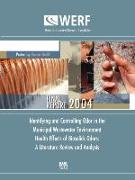- Start
- Identifying and Controlling Odor in the Municipal Wastewater Environment - Health Effects of Biosolids Odors: A Literature Review and Analysis
Identifying and Controlling Odor in the Municipal Wastewater Environment - Health Effects of Biosolids Odors: A Literature Review and Analysis
Angebote / Angebote:
Identifying and Controlling Odor in the Municipal Wastewater Environment, Health Effects of Biosolids Odors: A Literature Review and Analysis WERF Report: Protecting Human Health (Project 00-HHE-5C) Author(s): WS Cain, JE Cometto-Muñiz This report deals with whether the experience of odors, i.e., odors as sensations, from biosolids at wastewater treatment plants (WWTPs) causes illness. There exists no repository of information on the numbers of complainants with illness, their specific complaints, or the relationship between degree of exposure and complaints. Anecdotal reports nevertheless imply a pattern much like that associated with other industrial malodors. Any connection between odor and illness has received little note among the millions of articles in the medical literature. This state of affairs presumably exists because odors per se generate no objective signs of illness in otherwise healthy persons. However, malodors may exacerbate both symptoms and signs of illness in persons with certain chronic disorders, such as asthma and migraine. Vulnerability to such effects may vary considerably from person to person. Symptoms claimed in connection to odors from biosolids in particular seem to come from olfactory rather than chemesthetic (irritating) stimulation, a conclusion derived from calculations that concentrations of emissions of the notable contaminants from WWTPs fail to reach irritating levels even within the grounds of facilities. Any convincing deviation from this expectation would warrant serious attention. Although not inappropriate to the experience of malodors, the symptoms seem to occur via intermediate variables, such as annoyance, anxiety, and frustration. Persons who experience no such distress experience no symptoms. This may prove true for persons with existing illness, but in some cases distress may affect the illness via hormonal mechanisms. Acknowledgment that odors cause anxiety and the like should inform strategies for how to deal with reports of symptoms. Research into the connection between the composition of the emissions from WWTPs and odor character should seek to illuminate quantitative goals that engineers can seek to achieve. Finally, failure to respect the boundary between the subjective and the objective in discussions of the matter can invite flatly incorrect conclusions about the relationship between odors and illness.
Folgt in ca. 15 Arbeitstagen
